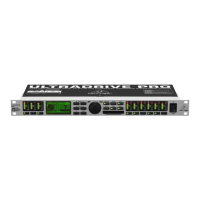8
ULTRADRIVE PRO DCX2496
2. CONTROL ELEMENTS
Fig. 2.3: Output LEDs
Outputs 1-6 each have a six 5-segment LED display (plus
MUTE, CLIP and LIMIT LED) showing the respective output
levels.
Like the input stages, the output stages should not be
overdriven, i.e. the CLIP LED should not illuminate.
The LIMIT LED illuminates when the limiter for the corres-
ponding output has been activated and is operating.
The bottom LED indicator (#8) is the MUTE LED, which
illuminates as soon as the corresponding output is muted
(see chapter 4.6).
Output channel buttons, with which you can enter the outputs
1-6 (see chapter 4.5) or mute or reactivate individual outputs
in MUTE mode (4.6).
Use the POWER switch to put your DCX2496 into operation.
The POWER switch should always be in the Off position
when you are about to connect your unit to the mains.
2.2 Rear panel
Fig. 2.4: Mains connector and RS-232/RS-485 interface
This is the FUSE HOLDER of your DCX2496. Blown fuses
must be replaced by a fuse of the same type and rating.
The mains connection is an IEC receptacle. An appropriate
power cord is included.
The 9-pin RS-232 interface allows you to connect your
DCX2496 to a computer. This enables you to save and load
files, update the DCX2496 operating software, or remotely
control one or several ULTRADRIVE PRO units from a PC.
Free editor software can be downloaded at
www.behringer.com.
When you have daisy-chained several ULTRADRIVE PRO
via the LINK connectors (see ), please press the TERM
switch on the first and last unit of the chain, to avoid data
reflections and transmission errors.
+ General rule: As soon as one device in the chain is
integrated into the system via only one of the LINK
connectors, the TERM switch must be pressed (ON).
Detailed information on this can be found in chapter
4.2.6 MISCELLANEOUS.
Use the LINK connectors A and B (RS-485 network interface)
and a commercially available network cable to daisy-chain
several ULTRADRIVE PROs.
Fig. 2.5: Output connectors
Balanced XLR output connectors for output channels 1-6.
Connect your power amps here.
Fig. 2.6: Input connectors
Balanced XLR input connectors A, B and C are used for
connecting input signals. Input A can also be used for digital
AES/EBU input signals. Input C can be used for line signals
or for connecting a measuring microphone. If AUTO ALIGN
has been enabled in the SETUP menu (see chapter 4.2.2),
input C will be set for mic levels automatically. Additionally,
phantom power for the measuring microphone will be
switched on.

